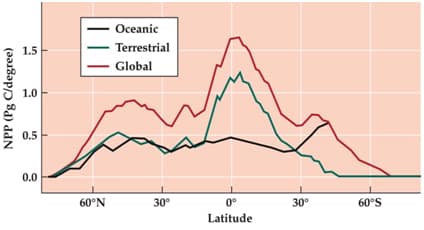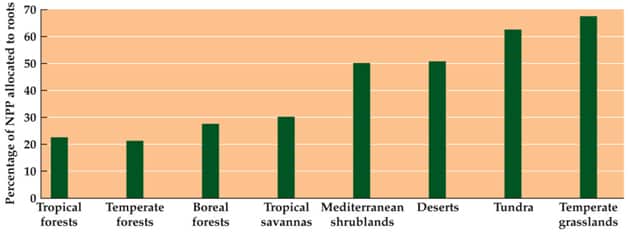The term ecosystem was first used by Tansley (1935) to refer to all the components of an ecological system, biotic and abiotic, that influence the flow of energy and elements.
The ecosystem concept integrates ecology with other disciplines such as geochemistry, hydrology, and atmospheric science.
Primary production is the chemical energy generated by autotrophs during photosynthesis and chemosynthesis.
Primary productivity is the rate of primary production.(production- amount productivity- amount/time)
Energy assimilated by autotrophs is stored as carbon compounds in plant tissues, thus carbon is the currency used to measure primary production.
Gross primary production (GPP)
Total amount of carbon fixed by autotrophs. GPP depends on photosynthetic rate.
Photosynthetic rate is influenced by climate and leaf area index (LAI)—leaf area per unit of ground area. (no unit) can increase through leaf stacking and overlap.
Net primary production (NPP):
- NPP = GPP – Respiration
- NPP represents biomass gained by the plant.
- NPP is the energy left over for plant growth, and for consumption by detritivores and herbivores.
- NPP represents input of carbon in ecosystems. Plants can respond to environmental conditions by allocating carbon to the growth of different tissues.
- Allocation of NPP to storage products (e.g., starch) provides insurance against loss of tissues to herbivores, disturbances such as fire, and climatic events such as frost.
- Substantial amounts of NPP (up to 20%) may be allocated to defensive secondary compounds.
- NPP is the ultimate source of energy for all organisms in an ecosystem.
- Variation in NPP is an indication of ecosystem health.
- NPP is associated with the global carbon cycle.
In terrestrial ecosystems, NPP is estimated by measuring increase in plant biomass in experimental plots, and scaling up to the whole ecosystem.
Harvest techniques: Measure biomass before and after growing season. This is a reasonable estimate of aboveground NPP if  corrections are made for herbivory and mortality.
corrections are made for herbivory and mortality.
Harvests must be more frequent, and additional correction factors are needed.
Minirhizotrons are underground viewing tubes outfitted with video cameras.
They allow researchers to directly observe root growth and death.
They have led to significant advances in the understanding of belowground production processes.
Harvest techniques are impractical for large or biologically diverse ecosystems.
Chlorophyll concentrations can be a proxy for GPP and NPP. They can be estimated using remote sensing methods that rely on reflection of solar radiation.
Chlorophyll absorbs blue and red wavelengths and has a characteristic spectral signature.
- NPP can also be estimated from GPP and respiration measurements.
- Change in CO2 concentration is measured in a closed chamber.
- Sometimes whole stands of plants are enclosed in a chamber or tent to study CO2 exchange.
- The net change in CO2 is GPP minus total respiration: Net ecosystem production or exchange (NEE).Net Sink: Over a year more net carbon shows an intake of CO2 Net Source: Over a year more net carbon shows an output of CO2 (based on the season, ecosystem can move between the two) or even the time of day (sunlight- sink dark– source)
- Photosynthesis and respiration are measured in water samples collected and incubated onsite with light (for photosynthesis) and without light (for respiration). The difference in the rates is equal to NPP.
Environmental Control
- NPP varies substantially over space and time. Much of the variation is correlated with climate.
- NPP increases as precipitation increases, up to a point. At very high precipitation levels, there is usually heavy cloud cover, so less light, and wet soils can become hypoxic.
- NPP increases with increasing average annual temperature.
- But ecosystem carbon storage (NEE) does not necessarily increase. Warmer temperature also increases respiration rates and loss of carbon.
- Climate influence on NPP can also be indirect, mediated by factors such as nutrient availability.
- Many experiments indicate that nutrients, particularly nitrogen, control NPP in terrestrial ecosystems.
- Increase in NPP was not uniform across all plant types.
- Change in NPP in the dry meadow resulted from change in species composition. The dominant plant biomass did not increase as much as others.
- In the wet meadow, the dominant’s biomass increased more than the others.
- In the open ocean, NPP is mostly limited by nitrogen. But NPP in the equatorial Pacific Ocean appears to be limited by iron (Martin et al. 1994). However iron is not a global solution to limiting C02
Global Patterns of NPP
Global patterns of net primary production reflect climatic constraints and biome types. 
Remote sensing data now provides direct measurements of NPP.
Highest rates of NPP on land are found in the tropics.
Variation in NPP in terrestrial biomes is associated mostly with leaf area index and length of growing season.
Variation in NPP in aquatic ecosystems is primarily related to variation in nutrient inputs. Oceanic NPP peaks at mid-latitudes, where zones of upwelling are found. Upwellings bring nutrient-rich deep water to the surface.
Secondary Production
- Heterotrophs get their energy by consuming organic compounds that were produced by other organisms: Secondary production.
- Stable isotopes are often used to determine an organism’s diet.
- The isotopic composition of an organism is compared with potential food sources.
- Concentrations of naturally occurring stable isotopes of carbon (13C), nitrogen (15N), and sulfur (34S) differ among potential food items.
- Not all the organic matter consumed by heterotrophs becomes heterotroph biomass. Some is used in respiration, some is egested (lost in urine and feces).
- Net secondary production = Ingestion – Respiration – Egestion


